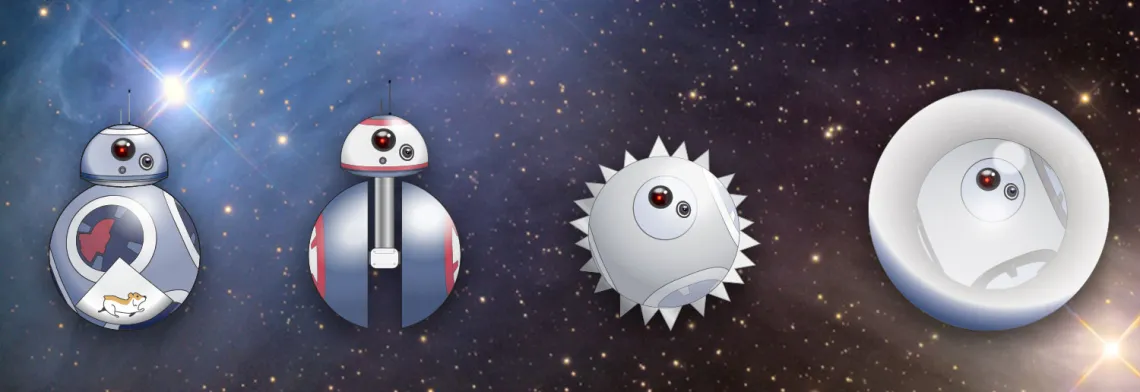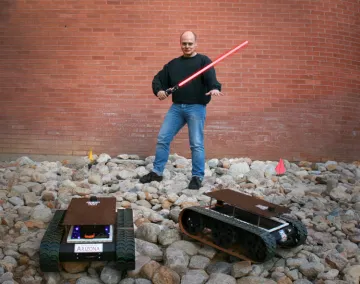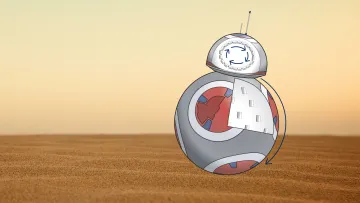How could a real-life BB-8 work?
Wolfgang Fink is a world-renowned roboticist who engineers free-thinking Mars rovers. As an avid “Star Wars” fan, these days he’s particularly interested in BB-8 and how he might build one in real life.

The real star of the upcoming “Star Wars” movie may not be a human or a Wookie. Instead it may be a round, two-foot tall astromech droid called BB-8. He may look great on screen, but can BB-8 exist in real life?
University of Arizona researcher Wolfgang Fink would know, as both an expert in artificially intelligent Mars rovers and an unabashed “Star Wars” fan.
As a longtime “Star Wars” devotee and someone who spends an awful lot of time around robots, Fink has done his fair share of thinking about the astromech droids seen in the franchise. With J.J. Abrams’ “Star Wars: The Force Awakens” opening in theaters this month, he’s focused on BB-8.
Compared to that of R2-D2 and C-3PO, Fink says BB-8’s design has “a striking advantage.”
“R2-D2 is on three legs and rolls around, so the challenge there would be if you have rugged terrain. Now, of course, C-3PO is a humanoid robot and can climb just like we do,” says Fink.
Fink is an associate professor of electrical, computer and biomedical engineering at the University of Arizona, as well as the Keonjian endowed chair in microelectronics. In his lab, he designs and builds artificially intelligent, autonomous Mars rovers. But as he reflects on his love of “Star Wars” in an intentionally dim office, he’s wielding a crimson red light saber that vacillates between a dull hum and a piercing whoosh as he waves it left to right.

“I grew up on the original ‘Star Wars.’ It started out as this space fairytale, really, and, decades later, I’m now the proud owner of this light saber,” says Fink. “It’s not just a movie to me.”
BB-8’s soccer-ball-like body is a smart choice, according to Fink, and a natural progression from its predecessors. By comparison, he explains, BB-8’s spherical, minimalistic body makes it a good candidate for covering rugged terrain and swimming, assuming it’s light enough. And, “with fewer moving parts, there’s less that can be broken.”
Thumbing through a list of them, he adds, “Plus, spherical robots exist in real life.” One such robot, GroundBot, was built to survey the types of terrain where a droid like R2-D2 might fail: mud, sand and water.
Much like Luke Skywalker’s sassy confidant, R2-D2, and the neurotic, courtly C-3PO before it, BB-8 will have a personality all its own. Fink, who algorithmically instills the personality trait of curiosity into his own robots, believes this is fundamental: “Over the next few decades, robots will become an integral part of society. If robots have personalities, it’s a lot easier to bridge the gap between us as humans and them as machines. It’s not just a block of steel or a foreign object anymore.”
But for all of its triumphs, Fink does see room for improvement on BB-8.
With such a smooth surface, BB-8 would have a tough time rolling uphill. At risk of looking slightly less sleek, adding a layer of texturized material, like rubber car tires, would go a long way in terms of traction.
Fink would also consider adding a gyroscope—a spinning wheel that resists changes in direction—to help stabilize the droid’s movement.

Top view of the barbell-bodied robot
Then, there’s BB-8’s “head.” Although it lends itself well to adorability, BB-8’s head presents a challenge. If Fink were tasked to build a droid with a head like BB-8’s, he might deal with it in one of two ways. The first, creating a barbell-like body with the head attached to the top via a steel bar through the middle, is limiting. It would allow the robot to move forward and backward, but not side to side. The second relies on a group of mobile, attracting and repelling, heavy-duty magnets inside both the head and the body to cling to each other as BB-8 moves. In this design, he says, the head would be able to control the movement of the body in any direction.

Regardless, Fink appreciates the ingenuity of “Star Wars.”
“I’m a total fan. ‘Star Wars’ has always been decades ahead of its time, and we’re just catching up with robotics to make similar things happen. In some ways, it actually leads and inspires what is to come, and in that sense, it’s not even science fiction; it’s science fact-ion.”

